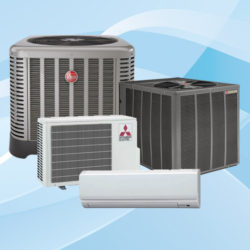Blog
The 3 Most Common Central Air Conditioning Systems
 Summer is coming and if you are considering installing air conditioning this season, you may be curious about your options. Air conditioning is a big investment, but with a little homework you can ensure that you get the right system — one that adds value to your home and will keep you cool for years to come. The 3 most common systems are central air conditioning, heat pump air conditioners and split ductless systems. Here is an overview of each type.
Summer is coming and if you are considering installing air conditioning this season, you may be curious about your options. Air conditioning is a big investment, but with a little homework you can ensure that you get the right system — one that adds value to your home and will keep you cool for years to come. The 3 most common systems are central air conditioning, heat pump air conditioners and split ductless systems. Here is an overview of each type.
1. Central Air Conditioning
Most central air conditioning systems are comprised of an outdoor unit that houses the compressor and condenser coil, and an indoor evaporative coil that is typically installed in conjunction with the furnace or air handler. The compressor pumps chemical refrigerant through the system. The heat energy in your home transfers to the refrigerant inside the coil as air blows across the indoor evaporator coil. The heat absorbed by the refrigerant is moved outside your home while cooled air is blown inside. This happens over and over throughout the day. In addition, moisture is also condensed out of the air, lowering humidity.
2. Heat Pump Air Conditioners
A heat pump does double duty, heating your home in winter and cooling in summer. Heat pumps work best in climates with moderate temperatures. This system also consists of two parts. The indoor unit is called an air handler. The heat pump is the outdoor unit and is similar to a central air conditioner. A compressor circulates refrigerant that cools the air as it moves between the two units. The job of the heat pump is to move warm air from inside to outside in the summer, and from outside to inside in the winter. Even when it is cold outside, the heat pump captures the heat energy in the air and moves it indoors.
3. Split Ductless Systems
Like the other two systems, ductless mini-splits have an outdoor compressor/condenser and an indoor air handler. One advantage of split ductless systems (also called ductless mini splits) is flexibility. The air handler can be suspended from a ceiling, mounted flush in a drop ceiling, or hung on a wall. This type of system is often used as a retrofit in homes or room additions that don’t have existing air ducts, and in multifamily housing or commercial buildings. Another advantage of a split ductless system is its usefulness in zone heating. Because the unit is small, you can install one or a few just in the areas you need, and they can all be controlled independently of one another. Mini-splits are also efficient because no energy is lost by air traveling through ducts.
IAQ serves homeowners in Highlands Ranch and the Greater Denver Metro Area. We are here to help you decide which air conditioning system is right for you. Call us today for more information!




